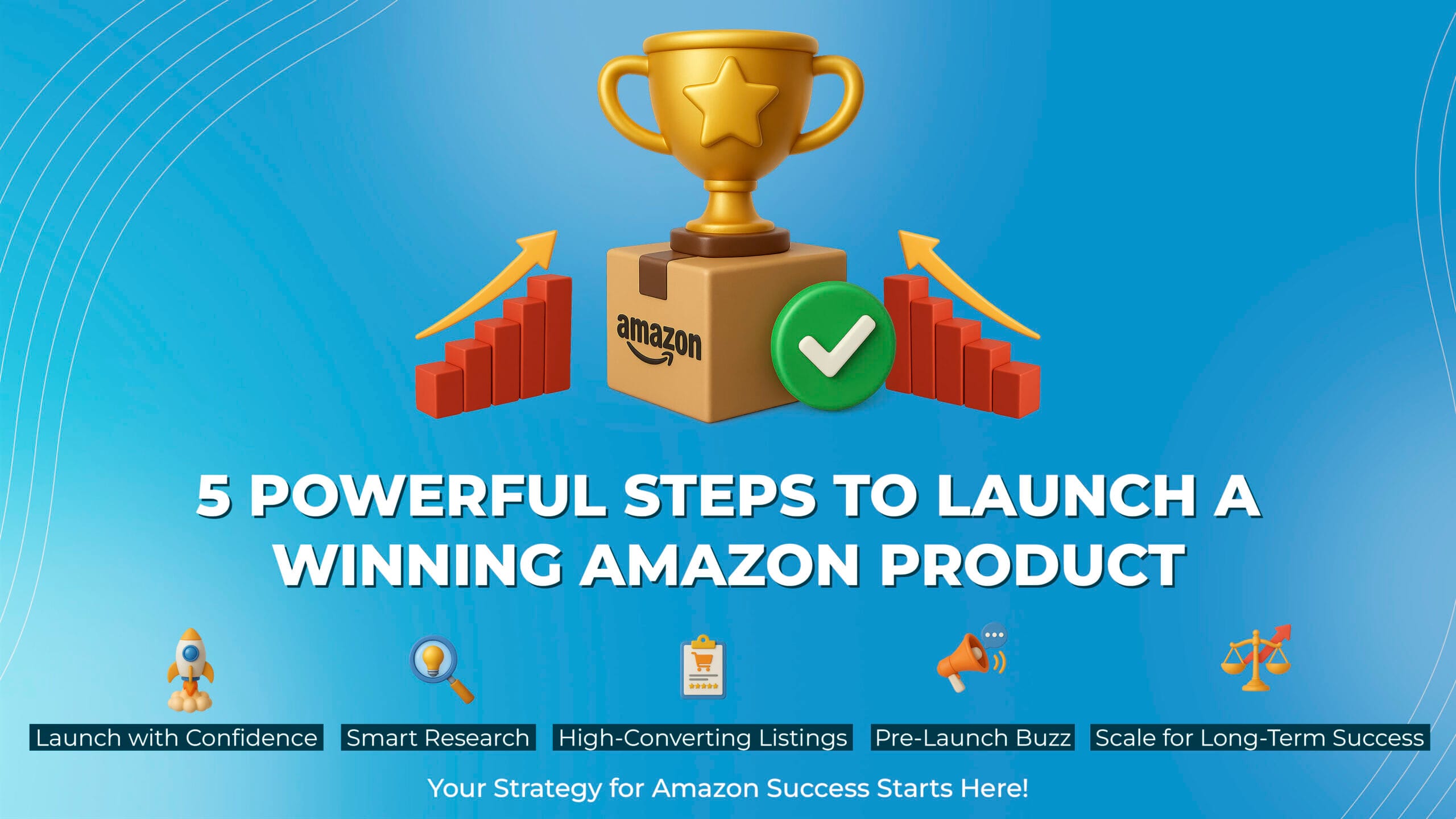Launching an Amazon product successfully isn’t about luck; it’s about strategy. In the highly competitive Amazon marketplace, the right launch plan can generate early momentum, attract loyal customers, and position your brand for long-term growth.
Here are five powerful, proven steps to ensure your Amazon product launch makes a lasting impact.
1. Validate Your Product with Smart Research
Success on Amazon starts long before your product goes live. Solid research helps ensure you’re launching a product that people actually want and that you can compete in your chosen niche.
Start by identifying trends and demand using tools like Jungle Scout, Helium 10, or AMZScout. These platforms can help you:
- Analyze keyword volume and competition
- Understand pricing and margin potential.
- Identify product gaps based on customer reviews.
Look closely at the top-performing listings in your category. Pay attention to what they do well and where they fall short. This will give you an opportunity to position your Amazon product as the better alternative.
You can also hire an expert to conduct the product research for you. Contact us, and one of our experts will take this step off your plate.
2. Build a High-Converting Product Listing
Your product listing is your digital storefront, and it’s often your only shot at turning browsers into buyers. It needs to be optimized for both Amazon’s algorithm (A9) and human psychology.
Key components of a great listing include:
- Title: Clear, keyword-rich (including “Amazon product”), and front-loaded with the most important details.
- Images: High-quality, lifestyle-oriented visuals that demonstrate use, size, and benefits.
- Bullet points: Focus on customer benefits. Don’t just list features, explain how they solve problems or improve life.
- Product description or A+ Content: Use persuasive language and formatting (if available) to educate further and convince.
According to Amazon Seller Central, a listing with 7+ images, optimized titles, and clear benefits tends to convert better. Use real customer language where possible, and test different elements over time to optimize performance.
3. Build Pre-Launch Buzz and Audience Interest
One mistake new sellers often make is launching their Amazon product in silence, simply going live and hoping the platform does the work. But without initial traffic or social proof, your listing can be overlooked. That’s why building anticipation before launch is so important.
Start by working with influencers or bloggers in your niche. You don’t need massive accounts; in fact, micro-influencers often have higher engagement and are more affordable. Provide them with samples ahead of time so they can review or promote your product when you go live. Contact us today, and we can connect you with appropriate influencers who can help you build the hype.
Another powerful pre-launch tactic is setting up a simple landing page where people can sign up for early access or an exclusive launch discount. Services like ConvertKit or Mailchimp make it easy to collect emails and send automated sequences to drive traffic on launch day.
By the time your product is live, you want a warm audience ready to buy. That early momentum can help your product rank better in Amazon’s search algorithm, known as the A9.
4. Choose the Right Launch Strategy to Drive Momentum
Once your Amazon product is listed, you’ll need a smart launch plan that aligns with your goals, audience, and inventory readiness. There are three common launch strategies, each suited to different seller needs.
Soft Launch
A soft launch is ideal for new sellers or those testing a new product category. It involves minimal promotion and focuses on gathering feedback, optimizing your listing, and validating demand.
Benefits of a soft launch:
- Reduces risk by limiting exposure
- Helps uncover issues before a major rollout
- Allows you to test and refine PPC ads at a lower cost
This strategy works best when you’re still learning the ropes or when launching a new Amazon product without a large existing audience.
Hard Launch
A hard launch involves an aggressive promotional push from day one. You’ll use Amazon PPC, influencer campaigns, social media ads, and email marketing to drive immediate traffic and sales.
It’s best for:
- Sellers launching a well-researched product with high demand
- Brands aiming for strong momentum and keyword ranking early
- Listings that are polished and ready to handle volume
A hard launch requires coordination and budget. You’ll need inventory ready, customer support on standby, and ad campaigns dialed in to handle the influx.
Seasonal Launch
This type of launch targets peak shopping periods like Q4, Black Friday, or Prime Day. It’s ideal for products that align with seasonal demand or make great gifts.
Key considerations for seasonal launches:
- Plan early: The Inventory should be ready months in advance
- Use holiday- or event-specific branding and packaging.
- Study previous sales trends to fine-tune your offer.
The upside? Massive volume potential. The downside? High competition and the risk of stockouts if demand exceeds forecasts.
Whichever strategy you choose, make sure you launch with at least 5–10 initial reviews (via Amazon Vine or ethical email follow-ups), use targeted Amazon ads to drive traffic, and offer limited-time deals or coupons to boost conversions.
Launching without momentum is like opening a store in the desert. These strategies give you the visibility and sales velocity needed to thrive.
5. Optimize and Scale for Long-Term Growth
Your work is far from over after launch. The post-launch phase is where true growth happens. This is when you gather data, test changes, and optimize to improve performance and scale profitably.
Focus on:
- Monitoring key metrics like CTR, conversion rate, and ACoS using tools like Sellerboard or DataHawk
- Split-testing images, pricing, and product titles to improve conversions
- Updating keywords based on new search term reports
Customer feedback is another goldmine. If reviews highlight a recurring flaw or complaint, act fast. A minor product tweak can result in better ratings and more sales.
Once your Amazon product is gaining traction, explore options to scale:
- Launch complementary or bundled products
- Expand into new marketplaces (Amazon Canada, UK, etc.)
- Join the Amazon Brand Registry to access enhanced marketing tools.
Scaling smartly ensures your success isn’t short-lived. With each launch, you become more efficient, more data-driven, and better positioned to build a lasting brand.
Conclusion
Launching an Amazon product is no longer a simple plug-and-play task. It’s a process that requires preparation, strategy, and continual improvement. Whether you choose a soft launch to test the waters, a hard launch to make a big splash, or a seasonal approach to ride the wave of demand, what matters most is that your plan fits your product and goals.
The most successful sellers treat their Amazon business like a brand, not just a one-time sale. If you follow these five steps with the right mindset and tools, you’ll set yourself up for sustainable growth and long-term success on the platform.
Ready to Launch Your Amazon Product the Right Way?
At Brand Aventus, we specialize in turning product ideas into profitable Amazon success stories. Whether you’re launching for the first time or looking to scale, our team of experts handles everything: from listing optimization and PPC management to influencer outreach and launch strategy. Don’t go it alone, partner with Brand Aventus and launch with confidence.
Get in touch with us today and let’s make your Amazon product a bestseller.




